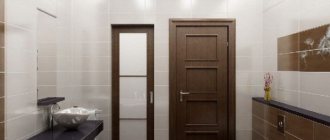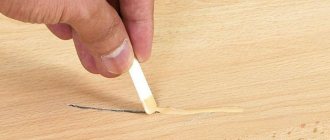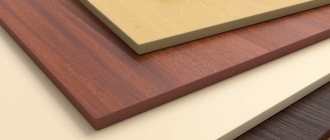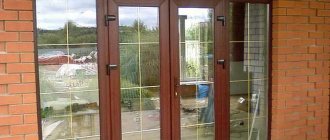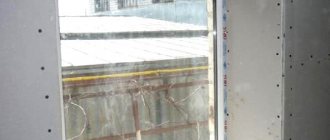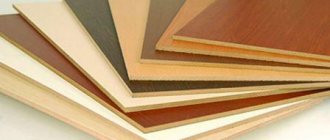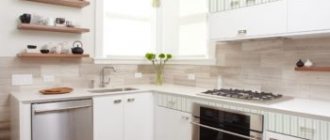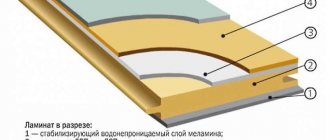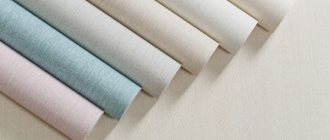Finishing MDF boards, covered on the front side with decorative film, are intended for covering walls in any room, for example, in the kitchen, hallway, with the exception of rooms with high humidity (bathroom, shower). MDF panel products are designed to carry only the function of protection, decoration and, in some cases, strengthening the wall structure.
Universal strips for MDF panels
Decorative fasteners are used as a decorative element on wall panels for interior decoration. The right fittings for MDF panels are essential to give the finishing touch to your home. This is very important not only for decorating rooms, but also for preserving the corners of the walls from damage. Therefore, components must be of high quality.
Finishing MDF is an easy way to transform a room at minimal cost
Today we will look at such a material for interior decoration as MDF panels. This type of product is excellent for carrying out budget repairs, and an additional advantage of this solution is that the installation work can be done without any problems with your own hands. I will describe the whole process in as much detail as possible, and you just need to use all the recommendations from this review.
Using MDF wall panels, you can transform a room in one day
Corners for protecting wall corners: selection options
This technique for decorating wall corners - protective corners - is not liked by everyone, but there are no special alternatives. In any case, on walls covered with wallpaper, a corner is still better than sticking out and torn canvases.
There is only one solution available for the integrity of the wallpaper without the use of decorative corners - to make a rounded corner rather than a sharp one. In this case, there will be no problem with finishing it. You can simply roll up the wallpaper without cutting it. But the corner must be drawn out perfectly, otherwise you will have to cut it again, which means that the question of protecting the wallpaper joint at the corner will again arise.
It is important to choose the right decorative corner so that it does not look alien. There are special techniques for this.
The interior looks good in the appropriate style
You need to select corners to protect the corners of the walls based on the overall design of the room. There are several standard solutions:
- To match the wall decoration. A complete color match is desirable, and even better if the texture is similar.
Either match the wall trim or match the doors
One of the options is quite logical
In general, you need to select corners to protect the corners of the walls depending on the design of the room. This can be done after the furniture has been arranged and textiles have been hung. In this case, it is easier to imagine the end result. Because the picture in our head can be very different from reality.
One of the transparent protective corners
If you just can’t find an acceptable color, and you need to protect the corners in your apartment, pay attention to the transparent plastic corners. They are of different types - rigid, flexible, with different wall thicknesses.
How the work is carried out
I’ll say right away that there are many ways to attach decorative MDF panels for interior wall decoration, but I’ll tell you about the option that I personally tested. The method is suitable for any base and allows you to quickly level even the most problematic surfaces.
We will talk about installing panels on a wooden frame; this is the most budget-friendly solution, which, among other things, is one of the easiest to implement.
What you need for work
You cannot start installation without having everything you need at hand; you will have to constantly be distracted and look for tools or go shopping in search of the right material. Therefore, make sure in advance that all the most important components are available:
The choice of options is great, so you can decorate the interior in different ways.
| Materials | Application |
| MDF panels | You can buy MDF wall panels for interior decoration at any more or less serious hardware store. Their colors can vary significantly depending on the manufacturer and collection, but most often the elements imitate the texture of wood, but there are also options for stone or brick. The width of the products is most often 250 mm, length 2.7 meters, as for the cost, it averages about 200 rubles per square meter |
| Wooden block | We will make a frame from it, the cross-section of the elements can be different, personally I use the 20x40 option, it is convenient and takes up little space. But if a balcony or loggia is being finished, then it may be necessary to lay insulation in the frame; in this case, the size of the block should be no less than the thickness of the heat-insulating material |
| Fasteners | The easiest way is to use special fasteners, which are called clamps and are staples that secure the finish. Here it is important to choose an option according to the thickness of the protrusions on MDF, most often it is 2 or 3 mm, it is important that the structure is fixed securely |
| Universal corner | If you have internal or external corners, as well as joints, then you cannot do without a special universal corner. It is a strip with a line in the middle, along which the element can be bent both outward and inward, or you can use it straight as a connecting strip. This is very convenient, because you don’t need to buy different components |
| Liquid Nails | This composition is necessary for fixing the corners, it can also be used when finishing the door slope, I will talk about this in a separate section. Any composition that is suitable for MDF will do; all the information is usually indicated on the packaging, so choosing the right option will not be difficult |
MDF finishing corners bend the way you need
If you cannot find clamps, then you can use finishing nails 20-25 mm long and no more than 1.6 mm thick; with their help you can also quickly and reliably fasten MDF.
MDF wall panels for interior decoration are installed using the following set of tools:
- If you have walls made of brick or concrete, then you will have to fix the frame elements using quick-installation dowels. In order to drill holes for them, you need a hammer drill with a drill of the required diameter and length;
- For wooden bases, there is no need to drill holes; you can directly screw screws into them, and for work we need a screwdriver with attachments of the required size and configuration. If the wood is very hard, then you can use the same screwdriver to pre-drill holes of small diameter;
- Claypers are most often fastened with nails, so do not forget to take a small hammer - a weight of 300-400 grams is enough;
- MDF wall panels are fairly easy to cut, but to ensure perfect edge quality and speed up the work process, it's best to have a jigsaw on hand. Use it with a blade with a fine tooth size to ensure the best result. If you don't have a power tool, a fine-tooth wood saw or even a regular metal hacksaw will do.
Paneling
The panel, pre-cut to height, is fixed from the corner at a distance of 2-3 mm, but no more. Since the panels are joined together according to the “tenon and groove” principle, it is the “tenon” side that goes into the corner and is fixed with self-tapping screws on the rail. Pre-drilled holes for screws and countersunk holes will make the job easier. You should screw it almost to the very edge (with an indentation of 1-1.5 cm) - this way you will not damage the edges of the panel, and the screws will disappear later under the corner.
The opposite side (side of the groove) is fixed with clamps - the bracket is inserted into the inside of the groove and nailed to the rail with small nails. Thus, the main panel is tightly fixed to the frame, the remaining panels do not need to be nailed or screwed, they are simply inserted with a tenon into the groove, and secured with clamps on the side of the groove. The only exception is the last panel, when the wall “ends”. Most likely, the panel will either not fit, or there will be a small gap left to the adjacent wall. Here you need to insert an extension, securing it with self-tapping screws in the same way as fastening the first panel. This will not spoil the appearance, since the screws will later hide under the universal corner.
Slopes for entrance doors made of MDF: Advantages and disadvantages - Installation of slopes + Video
When decorating an interior, it is impossible to achieve a complete look without an aesthetic doorway. When decorating doorways, one of the important conditions is the creation of smooth and neat slopes. And here, slopes for entrance doors made of MDF have proven themselves to be excellent. They do their job perfectly and, moreover, hide the fasteners perfectly. With their help you can emphasize the beauty of the door.
Recently, MDF panels have become increasingly popular. The material is of sufficient quality and can be matched to any interior. There is a huge variety of types and colors of MDF panels that can satisfy even the most demanding customer. High-quality imitation wood looks like an expensive species.
Types of protective corners: from what materials
According to the area of application, corners are available for external (outdoor) and internal use. For now, let's talk about how to protect corners in an apartment and a house - indoors. Let's start with the materials. Corners for protecting wall corners can be:
- Made of plastic (PVC). Different colors, textures, there are even transparent ones.
- Made of metal. Brass, aluminum (polished and not), stainless steel, with or without painting.
- Wooden. Made from different types of wood, smooth, with relief.
The corner on the arch is covered with a flexible plastic corner
Cork corners to protect corners
The most popular are plastic corners for protecting wall corners. Don’t think that such protection looks poor. In any case, no worse than frayed corners. It’s just that there are different types of plastic – polished, with a metallic effect, with a satin (matte) surface, with different reliefs. It is clear that in order to find something specific or special, you will have to run around construction stores and markets. But there are many types of design. If the corners for protecting the corners of the walls are chosen correctly, they fit organically into the design without attracting attention at all. At the same time, they protect and decorate the joints very reliably.
General information
Advantages and disadvantages of MDF
Installing a doorway is a rather labor-intensive process in which accuracy is important. However, this work can be done with your own hands.
The following advantages of this material are highlighted:
- Affordability;
- ease of installation;
- aesthetics;
- the material has good density, which contributes to additional heat and sound insulation;
- environmentally friendly and safe material. Can be used for finishing both external and interior doors;
- Large range of colors;
- Resistant to rotting and mold deposits;
- are durable. The panels are not able to deform and swell;
- suitable for finishing doorways of any thickness.
Unfortunately, there are disadvantages here too. Firstly, this is not resistant to strong mechanical impact, but it is quite resistant to moderate impact. Once damaged, the panel cannot be repaired. Also, the material is not able to withstand high humidity.
DIY slope installation
Any work begins with preparation. It is necessary to remove all contamination from the surface to be finished, eliminate and repair all chips and cracks in the walls. If there is such a need, install waterproofing.
Then you need to take measurements and calculate the required amount of materials.
MDF panels come in two types: L-shaped finishing and wall.
The nuances of marking and sawing MDF
In order to most accurately mark the required fragments, it is better to use a square and patterns in addition to a tape measure. You need to start with the top panels. Basically, slopes have uneven edges at a slight angle. This needs to be displayed on MDF. After installing the first panel, apply the following elements. Marking and cutting are carried out during the installation process.
MDF is cut with a hacksaw, saw or jigsaw. The last one produces the most ideal cut without any burrs or chips.
Important: When installing side elements, do not forget about the presence of a threshold, as this will affect the height of the side bar.
What to attach to
The choice of method for attaching corners to protect the corners of walls depends on the material of the corner and on what surface they will be attached to. The most commonly used glue is glue. Moreover, “liquid nails” are among the leaders. This is a universal compound, but before purchasing, check that the specific brand can bond the materials you need.
You can put a corner on the glue if it is even, without large flaws. If there are holes/depressions, you are unlikely to glue it. In this case, you can use silicone. If you are gluing white corners, you can use white silicone. For colored ones it is better to take transparent ones. It is not advisable to use acidic everywhere. Although it is cheaper, it can damage metals or paint.
In both cases, the wall and corner must be clean and dry. The compound is applied to the corner, it is pressed against the corner, and fixed with strips of masking tape. We grab it after 40-60 cm. If everything is smooth, you can do it after 60 cm; if you need to repeat the shape, after 40 cm or even more often.
How and with what to glue a PVC corner to the wallpaper
Leave it in this state until the glue dries or the silicone hardens. See the packaging for the exact time. Then the masking tape can be removed. It differs from ordinary tape in that it comes off even from paper wallpaper without damaging the surface. But to be sure, try sticking and peeling in an inconspicuous place.
Foam rubber corner - L-shaped and universal with self-adhesive backing
There is another option for how to glue corners to a wall with wallpaper or paint. You can use double-sided tape. First glue it to the corner, then, after removing the protective coating, press it to the corner. There are corners to which the tape is already glued. Some types of foam rubber or plastic (usually flexible or universal).
Conclusion
To finish a door using MDF panels, you need to select the right panels in style and color. It is important to take into account the interior of the rooms that are in contact with this doorway.
It is necessary to achieve harmony between the door leaf and the opening, as well as their integrity. You need to try so that the heads of the screws do not protrude. They must be covered with special covers.
MDF panels, due to their combination of many advantages, variety of colors and stylistic solutions, and low cost, are considered the best solution for decorating door slopes.
Source: domsdelat.ru
Tile products
Colored corners for tiles are made of aluminum and its alloys.
They arrange a coating on it and polish it to a mirror shine. Varnish is applied on top or laminated. Thanks to this technology, the protrusions receive reliable protection. The decorative characteristics of the room are improved. On one side of the profile there is a perforated strip equipped with slits. Lay on the surface of the wall or on steps. The opposite side is decorative. On the opposite side it has a small internal protrusion. The side end of the tile is inserted here when the corners are laid. It is important that it fits tightly.
The tiled profile is not only intended for decorative purposes. It makes surfaces smooth during finishing work. Three-sided elements are provided for protruding corners. They allow you to close connections in three planes. They are placed at the junction of finishing profiles located at right angles.
Slopes for entrance doors made of MDF: Advantages and disadvantages - Installation of slopes + Video
When decorating an interior, it is impossible to achieve a complete look without an aesthetic doorway. When decorating doorways, one of the important conditions is the creation of smooth and neat slopes. And here, slopes for entrance doors made of MDF have proven themselves to be excellent. They do their job perfectly and, moreover, hide the fasteners perfectly. With their help you can emphasize the beauty of the door.
Recently, MDF panels have become increasingly popular. The material is of sufficient quality and can be matched to any interior. There is a huge variety of types and colors of MDF panels that can satisfy even the most demanding customer. High-quality imitation wood looks like an expensive species.
General information
Advantages and disadvantages of MDF
Installing a doorway is a rather labor-intensive process in which accuracy is important. However, this work can be done with your own hands.
The following advantages of this material are highlighted:
- Affordability;
- ease of installation;
- aesthetics;
- the material has good density, which contributes to additional heat and sound insulation;
- environmentally friendly and safe material. Can be used for finishing both external and interior doors;
- Large range of colors;
- Resistant to rotting and mold deposits;
- are durable. The panels are not able to deform and swell;
- suitable for finishing doorways of any thickness.
Installation
Installation of slopes can be done using the following methods:
Since MDF is a sheet material, it is easy to mark elements on it. There are times when for installation you need to join two panels on the wall. Here you can use the frame installation method. But if the installation can be done with solid elements, then it is quite possible to get by with the adhesive method.
How to mount the frame
When constructing the frame, a wooden sheathing is used, which also serves as a support. According to the technology, it will be necessary to install the slats on the wall in a horizontal position in increments of thirty centimeters, and attach them with dowels. The voids between them are filled with thermal insulation or construction foam.
Next, MDF panels of the appropriate size are attached to this frame. They are fixed with self-tapping screws, followed by special overlays.
Important: The integrity of the entire panel will depend on the accuracy and high-quality filling of voids.
Gluing method
The adhesive method is used mainly when the wall surface is perfectly flat and the laying seam is minimal in width. Also, when gluing panels, it is not always possible to use insulating material.
Important: When gluing MDF panels, all existing cracks and seams must be carefully sealed, and the surface treated with a special primer.
Using a level, beacons are installed in all directions, for which a solution is first applied. It is applied to the slopes and leveled along the beacons with a spatula. The solution is left for two days until completely dry.
The adhesive composition is applied to the inside of the parts, which are then applied to the wall.
Gluing of MDF elements should be done with special adhesives. This way you will be sure of reliable adhesion of surfaces and strong adhesion of materials. This will also eliminate the possibility of elements falling off in cases of mechanical stress and temperature fluctuations.
Glue selection
There are several types of glue for gluing decorative corners to wallpaper corners, which differ in chemical composition, purpose, method of application, and setting time. The most common adhesives for such work are:
- liquid Nails;
- polyurethane glue;
- silicone sealant.
Liquid Nails
The main advantages of this type of glue are: a high degree of strength, quick adhesion and good adhesion properties to the surface, which allows you to reliably attach plastic profiles to any material: wallpaper with a convex pattern, concrete, wood. It is possible to choose either colorless glue, which can be used to glue white corners to the wallpaper, or different colors. The disadvantages of the white adhesive mass include the fact that over time it begins to turn yellow and becomes visible at the seams and joints of the plastic.
Liquid nails vary in purpose and composition. They are universal, suitable for working with any materials, and special, which are used for gluing the materials specified in the instructions on the packaging.
Liquid nails may contain synthetic rubber and solvent-based mineral components or water-based acrylic. The first type is characterized by fast setting, moisture resistance, frost resistance, and good adhesion. Allows you to glue not only light plastic slats and profiles in wet rooms to moisture-resistant wallpaper, but also heavier materials. The downside is the strong unpleasant odor, which takes up to 48 hours to dissipate.
The second type is environmentally friendly and does not emit a strong odor, but its use is permissible only at temperatures above 0°C in dry rooms.
Liquid nails are easily applied to the surface using a special syringe.
Polyurethane glue
Advantages: strength, elasticity, excellent adhesion to the surface, rapid hardening, no contamination. Disadvantages: pungent odor and higher cost compared to other adhesive mixtures.
Polyurethane adhesive for plastic corners can be one-component, ready-to-use, or two-component, which requires mixing the components in the required proportion immediately before use.
However, when choosing a polyurethane adhesive, you should pay attention that not all adhesives of this type are suitable for gluing decorative plastic products to wallpaper. This information is indicated on the packaging.
Silicone sealant
This glue can be used not only for attaching plastic products to wallpaper, but also to facing panels made of PVC, MDF, and ceramic tiles.
However, silicone sealant is not the best choice for attaching plastic slats, since in some places they may not adhere tightly to the wallpaper, which will shorten its service life. Silicone with the highest adhesion rates can be used in places with low traffic intensity, where the likelihood of damage and chips is low. For plastic corners in high traffic areas, it is recommended to choose acrylic sealant.
The main advantage of silicone sealant is a durable and elastic seam, which is suitable for places subject to vibration (doorways, light partitions). Thanks to this, this adhesive mixture does not chip.
Conclusion
To finish a door using MDF panels, you need to select the right panels in style and color. It is important to take into account the interior of the rooms that are in contact with this doorway.
It is necessary to achieve harmony between the door leaf and the opening, as well as their integrity. You need to try so that the heads of the screws do not protrude. They must be covered with special covers.
MDF panels, due to their combination of many advantages, variety of colors and stylistic solutions, and low cost, are considered the best solution for decorating door slopes.
Source: domsdelat.ru


